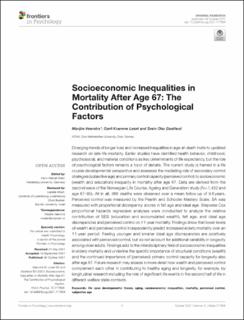Socioeconomic inequalities in mortality after age 67: The contribution of psychological factors
Peer reviewed, Journal article
Published version
Permanent lenke
https://hdl.handle.net/11250/2789018Utgivelsesdato
2021Metadata
Vis full innførselSamlinger
Originalversjon
10.3389/fpsyg.2021.717959Sammendrag
Diverging trends of longer lives and increased inequalities in age-at-death invite to updated research on late-life mortality. Earlier studies have identified health behavior, childhood, psychosocial, and material conditions as key determinants of life expectancy, but the role of psychological factors remains a topic of debate. The current study is framed in a life course developmental perspective and assesses the mediating role of secondary control strategies (subjective age) and primary control capacity (perceived control) to socioeconomic (wealth and education) inequality in mortality after age 67. Data are derived from the second wave of the Norwegian Life Course, Ageing and Generation study (N=1,432 and age 67–85). All in all, 366 deaths were observed over a mean follow-up of 9.6years. Perceived control was measured by the Pearlin and Schooler Mastery Scale. SA was measured with proportional discrepancy scores in felt age and ideal age. Stepwise Cox proportional hazards regression analyses were conducted to analyze the relative contribution of SES (education and accumulated wealth), felt age, and ideal age discrepancies and perceived control on 11-year mortality. Findings show that lower levels of wealth and perceived control independently predict increased elderly mortality over an 11-year period. Feeling younger and smaller ideal age discrepancies are positively associated with perceived control, but do not account for additional variability in longevity among older adults. Findings add to the interdisciplinary field of socioeconomic inequalities in elderly mortality and underline the specific importance of structural conditions (wealth) and the continued importance of (perceived) primary control capacity for longevity also after age 67. Future research may assess in more detail how wealth and perceived control complement each other in contributing to healthy aging and longevity, for example, by longitudinal research including the role of significant life events in the second half of life in different welfare state contexts.

